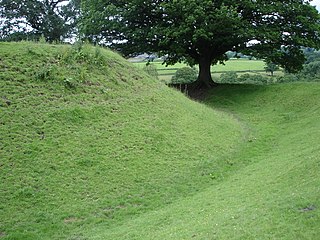Related Research Articles

Dafydd ap Gwilym is regarded as one of the leading Welsh poets and amongst the great poets of Europe in the Middle Ages.
Gwerful Mechain, is the only female medieval Welsh poet from whom a substantial body of work is known to have survived. She is known for her erotic poetry, in which she praised the vulva among other things.

The Oxford Book of Welsh Verse in English was a 1977 poetry anthology edited by the author and academic Gwyn Jones. It covered both Welsh language poetry, in English translation, and Welsh poets writing in English.
Medieval Welsh literature is the literature written in the Welsh language during the Middle Ages. This includes material starting from the 5th century AD, when Welsh was in the process of becoming distinct from Common Brittonic, and continuing to the works of the 16th century.

Sir John Wynn, 1st Baronet, was a Welsh baronet, Member of Parliament and antiquary.
Maredudd ab Ifan ab Robert, also spelt Maredudd ap Ieuan and Meredith ab Ieuan, was a Welsh noble and succeeded his father Ieuan ap Robert ap Maredudd (1437–1468). It is not known if he had any siblings. He purchased and rebuilt Gwydyr Castle after it was destroyed in the 1460s and made it the family home. He is an ancestor of Sir John Wynn, 1st Baronet.
Gruffudd Leiaf was a 15th-century Welsh poet, known almost exclusively from his works. He was reputed to descend from the royal family of Gwynedd.
Dafydd ap Edmwnd was one of the most prominent Welsh language poets of the Later Middle Ages.
Gruffudd Llwyd was a Welsh language poet.

Tudur Penllyn was a Welsh language poet during the time of the Beirdd yr Uchelwyr, the professional poets of the late Middle Ages.
Einion Offeiriad was a Welsh language poet and grammarian.
Sir Gruffudd Vychan was a Welsh knight who supported the rebellion of Owain Glyndŵr against the English, captured the Lollard John Oldcastle and was finally executed after the murder of Sir Christopher Talbot.

Anwyl of Tywyn are a Welsh family who claim a patrilinear descent from Owain Gwynedd, King of Gwynedd from 1137 to 1170 and a scion of the royal House of Aberffraw. The family motto is: Eryr eryrod Eryri, which translates as "The Eagle of the Eagles of Snowdonia." The family lives in Gwynedd and speak Welsh.

Gwerful Fychan was a poet during the period of the Welsh Beirdd yr Uchelwyr during the late Middle Ages. She came from a noble family, her full name in genealogies being given as Gwerful ferch Ieuan Fychan ap Ieuan ap Hywel y Gadair ap Gruffudd ap Madog ap Rhirid Flaidd, and was the heiress of the mansion of Caer-Gai, near Llanuwchllyn, Merioneth. The name Fychan was later anglicised as Vaughan.

Ieuan Deulwyn was a Welsh language poet or bard.
Alis ferch Gruffudd ab Ieuan ap Llywelyn Fychan or Alis Wen was a poet who wrote in Welsh.
Myfanwy Fychan was a Welsh noblewoman, born in the mid-14th century, who was involved in a famous romance with a bard.
Huw Cae Llwyd was a Welsh language poet from Llandderfel in the Dee valley of Merioneth as he witnessed in his Cywydd y Wennol.

"Owain Glyndŵr's Court", also known as "Sycharth" or "The Court of Owain Glyndŵr at Sycharth", is a cywydd by the Welsh bard Iolo Goch. It describes and celebrates the hall and household of his patron, the nobleman Owain Glyndŵr, at Sycharth in Powys. It cannot be dated exactly, but was probably written about 1390, before Glyndŵr's revolt against the English crown. It survives in as many as 24 manuscripts.
References
- ↑ Taylor, John Bernard. "Gwaith barddonol Ieuan ap Gruffudd Leiaf, Robert Leiaf, Syr Siôn Leiaf a Rhys Goch Glyndyfrdwy (PhD Thesis), Bangor University, 2014". Bangor University. Retrieved 16 December 2020.
- ↑ Taylor, John Bernard, 'Cipolwg ar Waith Ieuan ap Gruffudd Leiaf', Dwned 22 (2016), 11 - 24.
- ↑ Jones, J. R., 'The development of the Penrhyn estate to 1431' (M.A. thesis, University of Wales, 1955), 217.
- ↑ Bowen, D. J., 'Y Canu i Gwilym ap Gruffudd (m. 1431) o'r Penrhyn a'i Fab Gwilym Fychan (m. 1483)', Dwned, 8 (2002), 59 - 78.
- ↑ Huws, Bleddyn Owen, 'Ailadeiladu Bywyd ar ôl Gwrthryfel Glyndŵr: Tystiolaeth y Canu i Foelyrch', Dwned 13 (2007), 97 - 137.
- ↑ Taylor, John Bernard, "Gwaith barddonol...", 132 - 258